

Photos Mohenjo-daro. Information sur Mohenjo Daro. Un article de Wikipédia, l'encyclopédie libre.

Mohenjo-daro — littéralement le Mont des morts, un nom qu'il partage avec Lothal — est un site important de la civilisation de la vallée de l'Indus, on y trouve les vestiges d'une des plus grandes cités de l'âge du bronze Indien. Il est situé au Pakistan à 300 km au nord-nord-est de Karâchi. Ayant subi peu de dégradations modernes, son état de conservation est meilleur que celui d'Harappâ, et par suite, c'est une importante source d'informations sur la civilisation à laquelle la ville appartenait.
Elle a été construite durant le IIIe millénaire avant J. -C. et a été abandonnée à la fin du XVIIIe siècle av. Mohenjo-Daro. La description du village. Mohenjo-daro - Bio. Mohenjo-daro (archaeological site, Pakistan) Mohenjo-Daro. Mohenjo-Daro : Mystère. Reconstitution 3d. La civilisation de la vallée de l’Indus En 1921, des fouilles débutèrent à Harappa.

Les archéologues mirent au jour les maigres vestiges d’une grande cité. En 1922, un archéologue indien qui cherchait les vestiges d’un ancien temple bouddhiste mit au jour à 640 km d’Harappa les ruines d’une civilisation protohistorique. Lost City of Mohenjo Daro. A well-planned street grid and an elaborate drainage system hint that the occupants of the ancient Indus civilization city of Mohenjo Daro were skilled urban planners with a reverence for the control of water.

But just who occupied the ancient city in modern-day Pakistan during the third millennium B.C. remains a puzzle. "It's pretty faceless," says Indus expert Gregory Possehl of the University of Pennsylvania in Philadelphia. The city lacks ostentatious palaces, temples, or monuments. Pakistan : qui résoudra l'énigme de Mohenjo-Daro ? Mohenjo Daro: Could this ancient city be lost forever? 26 June 2012Last updated at 19:06 ET By Aleem Maqbool BBC News, Mohenjo Daro, southern Pakistan Aleem Maqbool looks around the archaeological site at Mohenjo Daro Pakistani officials say they are doing their best to save one of the most important archaeological sites in south Asia, Mohenjo Daro.
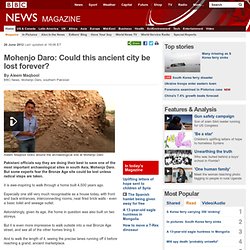
But some experts fear the Bronze Age site could be lost unless radical steps are taken. It is awe-inspiring to walk through a home built 4,500 years ago. Especially one still very much recognisable as a house today, with front and back entrances, interconnecting rooms, neat fired brick walls - even a basic toilet and sewage outlet. Astonishingly, given its age, the home in question was also built on two storeys. But it is even more impressive to walk outside into a real Bronze Age street, and see all of the other homes lining it.
And to walk the length of it, seeing the precise lanes running off it before reaching a grand, ancient marketplace. The upper town in the once thriving city. Bilawal Bhutto Zardari to raise funds to save Mohenjodaro. Indus Valley Civilization. The major sites of the Indus Valley Civilization imposed over modern borders The Indus Valley Civilization (IVC) was a Bronze Age civilization (3300–1300 BCE; mature period 2600–1900 BCE) extending from what today is northeast Afghanistan to Pakistan and northwest India (see map).

Along with Ancient Egypt and Mesopotamia, it was one of three early civilizations of the Old World, and the most widespread among them, covering an area of 1.25 million km2.[3] It flourished in the basins of the Indus River, one of the major rivers of Asia, and the now dried up Sarasvati River,[4][5] which once coursed through northwest India and eastern Pakistan together with its tributaries flowed along a channel, presently identified as that of the Ghaggar-Hakra River on the basis of various scientific studies.[7][8][9] The Harappan language is not directly attested and its affiliation is uncertain since the Indus script is still undeciphered.
Mohenjo-daro. Mohenjo-daro is an archeological site of one of the largest Indus Valley civilizations that thrived around 2000 BCE.
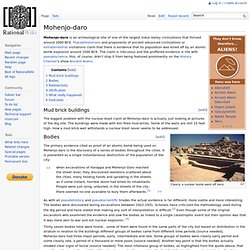
Pseudohistorians and proponents of ancient advanced civilizations or extraterrestrial visitations claim that there is evidence that its population was killed off by an atomic bomb explosion around 1500 BCE. The claim is ridiculous and the proffered evidence is rife with pseudoscience; this, of course, didn't stop it from being featured prominently on the History Channel's show Ancient Aliens.
[edit] Mud brick buildings Clearly a nuclear bomb went off here. The biggest problem with the nuclear blast claim at Mohenjo-daro is actually just looking at pictures of the dig site. [edit] Bodies The primary evidence cited as proof of an atomic bomb being used on Mohenjo-daro is the discovery of a series of bodies throughout the cities. As with all pseudohistory and pseudoscientific tirades the actual evidence is far different, more subtle and more interesting. [edit] Radioactivity.
Mohenjo Daro and Harappa - mrdowling. In 1856, a group of British railroad engineers uncovered an ancient and advanced civilization.
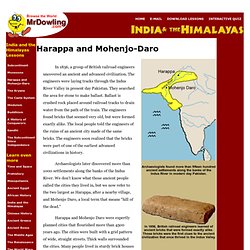
The engineers were laying tracks through the Indus River Valley in present day Pakistan. They searched the area for stone to make ballast. Ballast is crushed rock placed around railroad tracks to drain water from the path of the train. The engineers found bricks that seemed very old, but were formed exactly alike. The local people told the engineers of the ruins of an ancient city made of the same bricks. Archaeologists later discovered more than 1000 settlements along the banks of the Indus River. Mohenjo Daro. Les immenses ruines de la cité de Moenjodaro sont situées dans l’actuel Pakistan, province de Sind, à quelque 400 km au nord de Karachi.
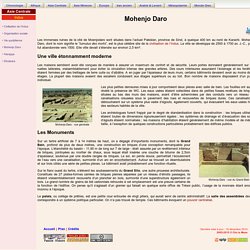
Mohenjo Daro, dont le nom signifie le “tumulus des morts”, est le plus célèbre site de la civilisation de l’Indus. La ville se développa de 2500 à 1700 av. J. -C., puis fut abandonnée vers 1500. Elle ville devait s’étendre sur environ 2,5 km2. Ruines archéologiques de Mohenjo Daro. Archaeological Ruins at Moenjodaro The ruins of the huge city of Moenjodaro – built entirely of unbaked brick in the 3rd millennium B.C. – lie in the Indus valley.
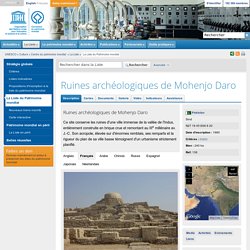
The acropolis, set on high embankments, the ramparts, and the lower town, which is laid out according to strict rules, provide evidence of an early system of town planning. Ruines archéologiques de Mohenjo Daro Ce site conserve les ruines d'une ville immense de la vallée de l'Indus, entièrement construite en brique crue et remontant au IIIe millénaire av. J. آثار موهنجودارو يحافظ هذا الموقع على أنقاض مدينة الوادي الهندوسي الكبيرة التي بنيت بكاملها من الآجر الخام والتي تعود إلى الألفية الثالثة ق.م. Source: UNESCO/ERI 摩亨佐达罗考古遗迹. Mohenjo-daro l'ancienne vallée de l'Indus ville en photos.
Mohenjo-Daro. Note utilisateur: Détails Catégorie : Archéologie Écrit par Sam Porter Affichages : 10323 Ce site constitue un véritable mystère, affirment les archéologues, qui auraient juré, avant la découverte de Mohenjo-Daro, qu’aucune véritable civilisation n’avait pu exister dans la vallée de l’Indus, au Pakistan, il y a environ 4 500 ans.
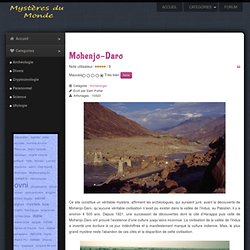
En 1921, des fouilles débutèrent à Harappa. Il faut imaginer un peuple qui a vécu sur un immense territoire. Le caractère le plus stupéfiant des villes harappéennes est la complexité de leur urbanisme. A proximité, des bains publics avaient été construits. Ce peuple était apparemment épris d’ordre et d’hygiène.